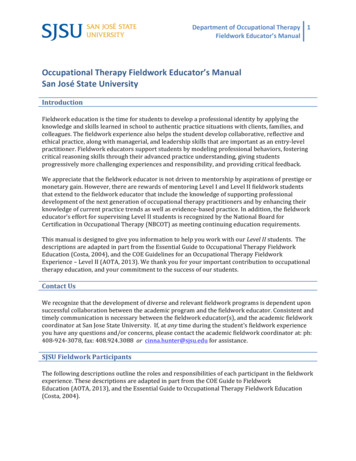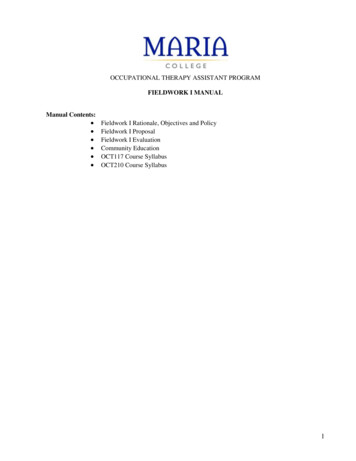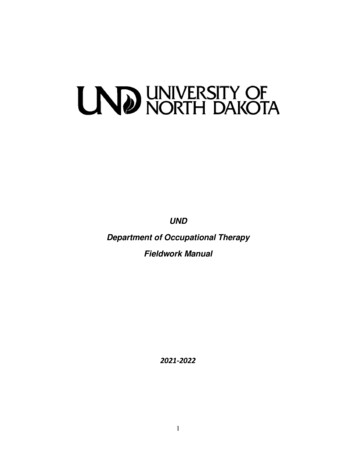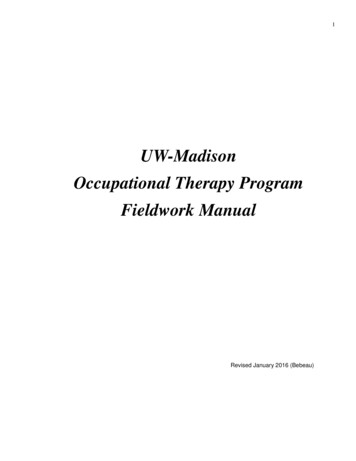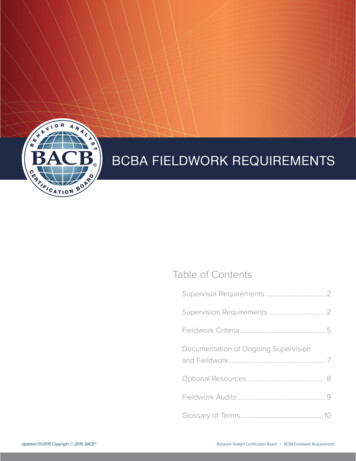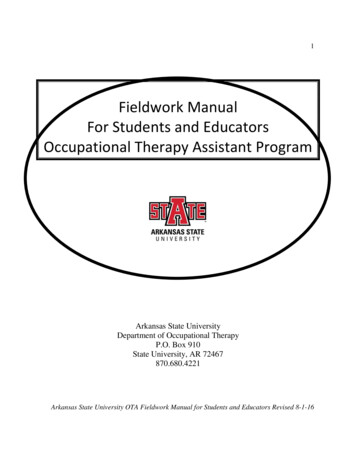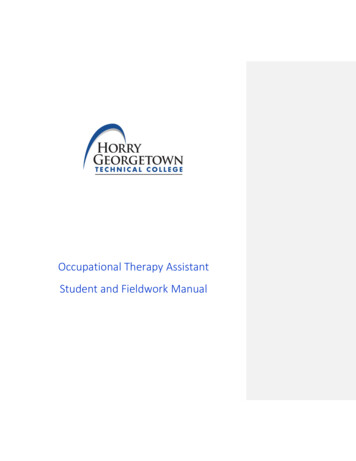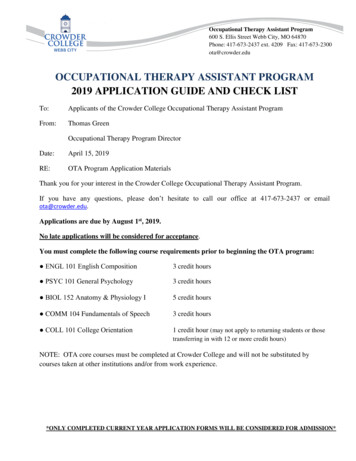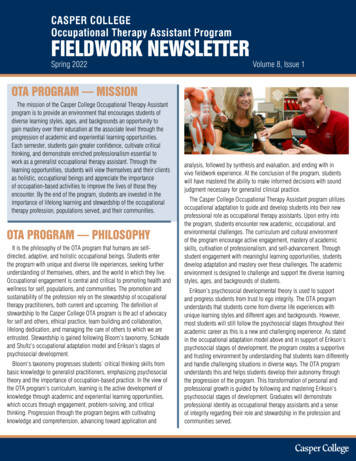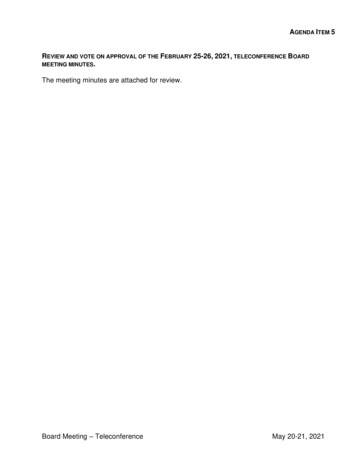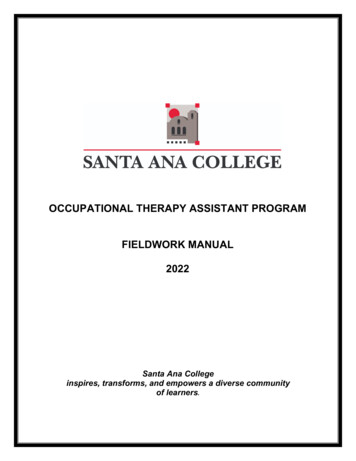
Transcription
OCCUPATIONAL THERAPY ASSISTANT PROGRAMFIELDWORK MANUAL2022Santa Ana Collegeinspires, transforms, and empowers a diverse communityof learners.
1
TABLE OF CONTENTSITEMPAGEA. General Policies for Level I and Level II Students2B. Level I Fieldwork1. Level I General Learning Objectives2. Level I Student Responsibilities3. Level I Fieldwork Educator’s Responsibilities4. Observation Assignment5. Level I Courseworki. OTA 102L - Psychosocial Components of Occupationii. OTA 103L - Physical Components of Occupation55666C. Level II Fieldwork1. Level II General Policies2. Level II General Objectives101012D. Criteria for Fieldwork Site Selection14E. Termination from Fieldwork Sites15F. Sample Schedule for Level II Fieldwork17G. Minimum skills for Santa Ana College OTA Program Students20H. Academic Honesty and Academic Accommodation Statements2172
Santa Ana CollegeOccupational Therapy Assistant ProgramFieldwork ManualClinical experience through fieldwork education is an essential part of the OccupationalTherapy Assistant (OTA) program at Santa Ana College (SAC). Fieldwork education isprovided during the 2nd & 3rd semester of the program. Consistent with the philosophy andcurriculum design of the program, fieldwork education is executed in a sequential mannerfrom basic foundational skills to specific aspects of occupational therapy practice acrossthe life span. The fieldwork experiences are designed to provide opportunities to integrateand apply academic learning at progressively higher levels of performance and professionalresponsibility under supervision. The goal of fieldwork education is to develop competent,entry-level generalists. For the OTA student to be trained as a generalist, Santa AnaCollege’s OTA program has affiliation agreements with a variety of clinical sites to providediverse clinical education. Facilities provide services to culturally diverse individualsacross the life span and represent a wide variety of service delivery models that arereflective of current practice in the profession. They provide an opportunity for the clinicalapplication of principles learned in the curriculum. These sites include but are not limitedto: General Hospitals, Psychiatric Hospitals and Day Programs, Rehabilitation Centers,Out-patient Clinics, Skilled Nursing Facilities, Hand Therapy Clinics, PediatricRehabilitation Clinics, Schools, Child Care Centers, Senior Citizen Programs, CommunityService Organizations and Private Practice Occupational Therapists.A.1.2.3.4.5.6.GENERAL POLICIES FOR LEVEL I AND LEVEL II STUDENTSEthical Behavior: Students are expected to follow the Occupational Therapy Code ofEthics as described in the Student Handbook, OTA 101, and OTA 201. A student is notable to pass fieldwork if a score of less than 3 is received on the fieldwork evaluationitem #1.Students are required to follow all standard safety precautions. A student is not able topass fieldwork if a score of less than 3 is received on the fieldwork evaluation items #2& #3.Students are required to maintain confidentiality as defined by HIPAA.Students are required to maintain current, original documentation in CastleBranch of amedical clearance examination, TB screenings, vaccinations, immunizations, and titersand provide copies of this documentation to assigned or potential sites on request.Facilities may have different policies regarding the validity of screenings and studentsare required to follow these policies. If the student fails to maintain currentdocumentation on file prior to the start of fieldwork or during the rotation, the studentwill be withdrawn from the site and fail the rotation.Students are required to maintain current documentation of CardiopulmonaryResuscitation (CPR) certification (BLS for Healthcare Providers) from the AmericanHeart Association.If a student fails to fulfill the site requirements (such as provide current documentatione.g., TB test, CPR certification in a timely manner, vaccination requirements, pass abackground check or secure a placement after being interviewed by the facility), the
7.8.9.10.11.12.13.14.15.student will fail the rotation and be unable to complete fieldwork as scheduled. Thestudent will have to wait until the class (OTA 102L, 103L, 202, or 203) is offered thefollowing semester. However, if this is a second course failure, the student will bedismissed from the OTA program as outlined in the Student Handbook.If a student is denied a fieldwork placement due to the results of a background check orbecause the student is unable to provide required documentation to fulfill thebackground check requirements, the student is responsible for providing the OTAProgram with documentation from both NBCOT and BOT proving that this same issuewill not prevent licensing. No new placement will be confirmed until such evidence hasbeen provided to the program.Students are required to pay a mandatory health fee on admission to the program. Thisgives them access to the Santa Ana College health center services. Additional chargesmay be incurred for certain services.During fieldwork, the student is required to provide the OTA Program and the facilitywith documentation to support absences. If a student withdraws from fieldwork becauseof illness or injury, the OTA Program will require medical clearance before the studentcan be reassigned to fieldwork.If sites require fingerprinting, criminal background checks, drug and alcohol screening,or update immunization/vaccination records, students are responsible for the cost.Placement at a site can be denied if the results are not acceptable. This may delay start offieldwork until the class is offered the following semester or result in dismissal from theOTA program.Sites may request the opportunity to interview the student. The AFWC will provide thestudent with contact details for the site. The student is responsible for scheduling theinterview and their attendance. Students must take any required documentation (healthinformation, CPR certification, malpractice insurance, vaccination/immunizationrecords) to the interview. Sites make the final determination on placement. If a student isdeclined by a facility, the student will need to wait until the class is offered the nextsemester. If the student is declined by 2 facilities, the student is deemed unable to beplaced and will not be able to complete fieldwork.If a student refuses to attend a facility, the student will need to wait until the class isoffered the next semester. If the student declines 2 facilities, the student is deemedunable to be placed and will not be able to complete fieldwork.Students are placed at sites by the Academic Fieldwork Coordinator. Students may notcontact facilities to schedule their own placements.Students are placed at sites that will provide them with a variety of experiences andenable them to exit the program as an entry-level generalist. The student’s interests,learning style, special skills and geographic location are considered, however, allplacements are subject to availability of the facility. Every effort will be made to placestudents living in Orange County within a 60-mile radius from the student’s residence.Students residing in other locations including neighboring counties (Los Angeles,Riverside, San Bernardino, and San Diego counties) are encouraged to meet with theAcademic Fieldwork Educator, however, placement outside of Orange County cannot beguaranteed. Students cannot complete fieldwork out of state or internationally.A Conflict of Interest may arise if (for example) a student has volunteered or worked ata site, has been a patient or client at a site, or is to be supervised by a family member or3
16.17.18.19.20.21.22.23.24.friend. The OTA Program faculty will make the final determination regarding placementof the student at the site.The OTA program does not inform the fieldwork site of a student's disability. Studentsthat choose to disclose disabilities must provide supporting documentation from theDisabled Student Programs and Services at Santa Ana College prior to disclosing.Accommodations cannot be provided retroactively to avoid a failing grade.For the safety of the student, the OTA program requires that students with medicalconditions obtain clearance from their physician prior to participating in fieldworkexperiences. The OTA program recommends that students inform the facility of theirmedical condition to ensure that the student receives any pertinent informationregarding safety from the facility. Students have the right to decline to disclose theirmedical condition. Facilities have the right to refuse to accept the student if they thinkthat the student will not be able to perform essential duties. Some facilities havepolicies in place that cover employees with certain medical conditions. Students wouldbe subject to these policies. Students may be required to have a medical release thatclears them for fieldwork and states any limitations. If the student is declined placementby the facility due to the medical condition, the AFWC will make every attempt to findan alternate placement. The student may have to wait until the next semester if analternate placement cannot be found.If students are absent due to medical appointments or other issues, they are required tomake up time missed. The facility is not obligated to extend the rotation and studentsmay need to repeat the entire rotation.Students are responsible for complying with the appropriate dress and uniform code ofthe facility. This may include a name tag or student badge. Lab coat or scrubs may berequired. The student must be clean and neat in appearance with good body and oralhygiene. Students are advised to wear closed toe shoes, limited jewelry, make-up, andscents. Pants and skirts are to be below the knee with no skin visible around thestomach, lower back, or chest. Jeans, t-shirts, tank tops and caps are not permitted.Tattoos must be covered and visible body piercings, except for simple earrings, must beremoved.Students are to report to the facility at the scheduled time. Both fieldworkcoordinators/educators and students need to provide advanced notice to the academicfieldwork coordinator as well as to each other of any scheduling changes.Holiday schedule: The student is required to adhere to the holiday policy of the facility.Tardiness: Promptness is expected as a professional behavior and tardiness is notacceptable. A student who is dismissed from a site die to issues with chronic tardinesswith fail the rotation. The student will need a remediation plan if a second rotation is aconsideration.Reporting of Accident: In the case of any accident, the student must report the incidentin accordance with the facility’s standard procedure. Students must report injuries to theschool within 24 hours of the incidentStudent problems: The academic fieldwork coordinator and the program coordinatorare available for consultation with either the student or fieldwork educator at any timefor problems, concerns, or emergencies. All advisement related to fieldwork is theresponsibility of the OTA faculty.4
25.26.Disputes regarding grades must be directed at the OTA program faculty who makes thefinal pass/fail determination.The Santa Ana College Occupational Therapy Program policies and procedures and theinformation in this fieldwork manual is subject to change.B. LEVEL I FIELDWORK(OTA 102L, OTA 103L)Level I Fieldwork is designed to be an integral part of didactic coursework through directedobservations and participation in selected in selected aspects of the occupational therapyprocess; and includes mechanisms for formal evaluation of student performance. Level Ifieldwork may be met through one or more of the following instructional methods: Simulated environments Standardized patients Faculty practice Faculty-led site visits Supervision by a fieldwork educator in a practice environmentThese experiences shall not substitute for any part of Level II Fieldwork and are notintended to emphasize independent performance. Level I Fieldwork shall be supervised byqualified personnel which include, but are not limited to licensed occupational therapists,certified occupational therapy assistants, speech pathologists, teachers, activity directors,physical therapists, social workers, nurses, recreational therapists.1. Level I General Learning ObjectivesDuring the Level I Fieldwork experience, students are expected to:1. Relate and/or apply classroom learning to practical settings through basic exposure,observation, and/or participative experience.2. Demonstrate professional work habits and behaviors.3. Establish meaningful and comfortable relationships with clients/patients and/orcaregivers.4. Establish positive working relationships with staff.5. Demonstrate good judgment in seeking assistance, responding to feedback andsupervision, and conducting him-/herself ethically and with appropriate courtesy in allworking relationships.6. Formulate general therapeutic goals and objectives appropriate for the specificpractical setting by utilizing the holistic approach and integrating information withassistance from the clinical educator.7. Demonstrate verbal and written communication in a clear, concise, and professionalmanner with assistance as necessary.8. Identify the various roles in which an occupational therapy assistant performs orfunctions in the setting to which the student is assigned.9. Observe the roles and functions of various team members in the treatment of thepatients/clients.5
10. Demonstrate responsibility and respect for the safety, age, gender, client/patientdiagnosis, cultural diversity, confidentiality of the patient/client and psychosocial factorsinfluencing engagement in occupation.11. Observe role delineation of OTR/COTA/aide if applicable.12. Observe administrative functions of the department and the role of OT in relation toadministrative procedures.13. Observe and participate in community-based treatment if possible.14. Conduct a structured or unstructured interview with a patient/ client or caregiver ifrequired to complete the student’s assignment.2. Level I Student ResponsibilitiesStudents are to:1. Contact the fieldwork coordinator or educator in accordance with the timelineproposed by the Academic Fieldwork Coordinator to schedule dates and times toattend the facility after receiving the assignment.2. Inquire regarding the dress code of the facility.3. Report to the facility at the scheduled time. Provide advanced notice to the academicand/or fieldwork site coordinator of any needed scheduling changes4. Provide their own transportation to and from sites and site-to-site.5. Maintain professional manner/professional relationships at all times. This includesmaintaining safety standards and confidentiality.6. Communicate promptly with the academic fieldwork coordinator regarding any specialneeds or problems with the fieldwork placement.7. Complete all written assignments within stated timeframe.8. Complete the fieldwork site evaluation form9. Maintain and ensure compliance of the attendance record3. Level I Fieldwork Educator’s ResponsibilitiesFieldwork Educators are to:1. Provide opportunities for basic exposure, observation, and participative experiences attheir discretion with clients/patients.2. Provide orientation to the practical setting.3. Provide supervision and necessary support to the students as well as ongoing verbalfeedback regarding progress or problems.4. Verify student’s attendance by signing the student attendance record.5. Complete the students’ performance evaluation form upon the completion of thefieldwork experience. Contact the Academic Fieldwork Coordinator should assistancebe needed to address student’s performance.4. Observation Assignmenti. OTA 101L - Exploration of OccupationConcurrent courses: OTA 100 - Medical Terminology and DocumentationOTA 101 - Foundations of Occupation and Occupational Therapy6
OTA 110- Human Occupation Across LifespanObservation Assignment:OTA 101L students engage in an observational experience. It is intended to introduce thestudent to Occupation across the Lifespan in a well population. The student is required toobserve 4 different individuals or groups: preschoolers, middle or high school students,adults, and seniors. Based on the Occupational Therapy Framework, the student identifiesthe ways in which context, activity and client factors influence participation in occupation.Relationship of the observation assignment to didactic curriculum:During the first semester of course work the students are learning about the role ofoccupational therapy and the theoretical frames of reference used in occupational therapy.During the observation, they can observe human occupation across the life span in terms ofADLs and IADL’s, rest and sleep, social participation, education, work, play and leisureand participate in the teaching/learning process consistent to OT practice. They are requiredto complete an activity analysis in each setting using the skills learned in the classroom.They also complete a written assignment that requires clear, concise, professional writtenreporting of their observations.Grading:Observation assignment accounts for 20% of the total grade in OTA l01L. The assignmentsare graded on completion of observational hours and completion of the written assignment.If the student does not pass this assignment on the first attempt, it must be repeated. If timeallows, the observation can be repeated during the semester. If the student does not pass theobservation on the second attempt, they will receive a failing grade.Criteria for observation site selection:1. Age-appropriate clientele suitable for student observation.2. Adequate variety of activities taken place at the site.3. Exposure to cultural diversity.5. Level I Courseworkii. OTA 102L - Psychosocial Components of OccupationConcurrent Courses: Psych 250 – Abnormal PsychologyOTA 115 – Human Disease and OccupationOTA 111 - Applied KinesiologyOTA 102 - Psychosocial Function and DysfunctionFieldwork Assignment:The level I fieldwork experience consists of 32 hours of observational practice ofpsychosocial dysfunction. The purpose of the fieldwork during the second semester is forthe students to develop their skills through directed observation with participation at theclinical educator’s discretion in a psychosocial setting. Consistent with the curriculumdesign, the complexity of fieldwork increases at this level. The students are required to7
complete a patient/client interview noting therapeutic use of self, document treatment usinga SOAP note format, and comment on the role of the OT in terms of the OTR/COTArelationship and/or the role the OT practitioner in relationship to other disciplines in thefacility. The student is also required to keep a journal to record treatment sessions observedand to note personal reaction to the fieldwork experience.Relationship of fieldwork to curriculum design and didactic coursework:During this semester, the students are learning about psychosocial dysfunction andoccupational therapy frames of reference and interventions for mental health in theclassroom. They are also continuing to develop their documentation skills and theirunderstanding of the role of occupational therapy. This fieldwork assignment allowsexposure to patients/clients with behavioral health, or psychological and social factorsinfluencing engagement in occupation, and the role of occupational therapy practitionersand other health care providers in mental health settings.Grading:Fieldwork accounts for 20% of the total grade in OTA l02L. Fieldwork assignments aregraded on completion of observational hours, formal evaluation of student performancecompleted by the fieldwork site educator and completion of the clinical assignments. TheLevel I student evaluation grading is based on that of the AOTA Fieldwork PerformanceEvaluation for The Occupational Therapy Assistant Student. It is graded on a 1 to 4 scale infour categories with 4 being the highest score. The maximum possible score for the 10items is 40 and the minimum possible score is 10. The student must successfully pass thestudent evaluation with a minimum of 75% (or a score of 30) and pass the clinicalassignments to pass this course.Criteria for fieldwork site selection:1. The responsibilities of each fieldwork site shall be clearly documented and accessible toall personnel and students on request. This documentation will include currentmemorandum of understanding or contracts, fieldwork site data forms, agreements tocomply with all site requirements, maintaining site objectives and site data andcommunicating this information to the student through email attachments or access tothe documentation.2. Objectives for the fieldwork experience shall be:2.1 developed with collaboration between the academic and the program fieldworkeducator prior to student assignment, during by on-site visits, formal and informalcommunication, and the AOTA evaluation of the student experience by the fieldworkeducator.2.2 communicated to the student through email attachments or access to thedocumentation.3. Settings include, but are not limited to, the following: psychiatric hospitals, mentalhealth clinics, community service organizations, day care programs, chemicaldependency program, gero-psychiatric programs, or child/adolescent mental healthprogram. Due to the limited psychosocial fieldwork sites, placement for this fieldworkmay also be at selected brain injury or pediatric programs.8
4. Fieldwork sites provide services to clients whose primary disabilities or needs aregrossly or precisely categorized as psychosocial in nature.5. Adequate designated qualified personnel for student supervision and formal evaluationof student performance.6. The facility values a client-centered approach and activities and services provided to theclientele are humanistic and culturally sensitive.7. Adequate opportunities are provided for students to observe and participate to fulfill theexpectations stated in the written assignment.iii. OTA 103L Physical Components of OccupationConcurrent Courses:OTA 103 - Physical Function and DysfunctionOTA 201 - Contemporary Models of Occupational Therapy PracticeFieldwork Assignment:During this semester the students are required to complete 32 hours of observationalfieldwork in a physical dysfunction setting. As the students’ skills continue to develop, thecomplexity of the fieldwork assignment continues to increase. At this level the student isexpected to complete an interview with a client in the role of a COTA, write notes in aSOAP format as well as the format used at the facility, and identify the role of OT in termsof the OTR/COTA relationship and/or the role the OT practitioner in relationship to otherdisciplines in the facility. The student is also required to examine therapeutic use of self.Additionally, the student is required to keep a journal to record treatment sessions observedand to note personal reaction to the fieldwork experience.Relationship of fieldwork to curriculum design and didactic coursework:This fieldwork relates to the classroom teaching of physical function and dysfunctionacross the life span. This includes information regarding a wide variety of diagnosis thatresult in physical dysfunction and current therapeutic approaches to treatment inoccupational therapy practice. The fieldwork allows the student the opportunity to observespecific physical deficits, evaluation procedures, and treatment approaches. In selectedsettings the student may have the opportunity to provide hands on treatment at thediscretion of their clinical educator.Grading:Fieldwork accounts for 20% of the total grade in OTA l03L. Fieldwork assignments aregraded on completion of observational hours, formal evaluation of student performancecompleted by the fieldwork site educator and completion of the clinical assignments. TheLevel I student evaluation grading is based on that of the AOTA Fieldwork PerformanceEvaluation for The Occupational Therapy Assistant Student. It is graded on a 1 to 4 scale infour categories with 4 being the highest score. The maximum possible score for the 10items is 40 and the minimum possible score is 10. The student must successfully pass thestudent evaluation with a minimum of 75% (or a score of 30) and pass the clinicalassignments to pass this course.9
Criteria for fieldwork site selection:1. The responsibilities of each fieldwork site shall be clearly documented and accessibleto all personnel and students on request. This documentation will include currentmemorandum of understanding or contracts, fieldwork site data forms, agreements tocomply with all site requirements, maintaining site objectives and site data andcommunicating this information to the student through email attachments or access tothe documentation.2. Objectives for the fieldwork experience shall be:2.1 developed with collaboration between the academic and the program fieldworkeducator prior to student assignment, during by on-site visits, formal and informalcommunication, and the AOTA evaluation of the student experience by the fieldworkeducator.2.2 communicated to the student through email attachments or access to thedocumentation.3. Sites include, but are not limited to, the following: hospitals, skilled nursing facilities,hand therapy clinics, out-patient clinics, pediatric settings, rehabilitation centers, orcommunity service organizations.4. Fieldwork sites provide services to clients whose primary disabilities or needs aregrossly or precisely categorized as physical dysfunction in nature.5. Adequate designated qualified personnel for student supervision and formal evaluationof student performance.6. The facility values a client-centered approach and activities and services provided tothe clientele are humanistic and culturally sensitive.7. Adequate opportunities are provided for students to observe and participate to fulfill theexpectations stated in the written assignment.C. LEVEL II FIELDWORK(OTA 202 and OTA 203)Level II fieldwork is designed to promote clinical reasoning and reflective practice, toconvey the values and beliefs that enable the application of ethics related to the profession,to communicate and model professionalism as a developmental process and a careerresponsibility, and to develop and expand a repertoire of occupational therapy assessmentsand interventions related to human occupation and performance.Level II fieldwork occurs at the end of classroom studies and consists of two 8-weekfieldwork sessions: one in a psychosocial setting and one in a physical dysfunction setting.Settings may be traditional or emerging providing a client–centered approach whereengagement in occupation to support participation is the preferred outcome of the therapyprocess. These settings provide students with the opportunity to be exposed to a variety ofclients across the lifespan and include opportunities for the students to deliver occupationaltherapy services that focus on the use of purposeful and meaningful occupation usingvarious service delivery models. Level II OTA Fieldwork students must be supervised byan occupational therapy practitioner, OT, or OTA, who meets state regulations and has aminimum of one year of practice experience, after initial certification.10
1.Level II General Policies1. The student needs to complete and pass a minimum of 16 weeks (2x 8-week) full timeLevel II Fieldwork rotations to graduate. Typically, placements are for 5 days a weekfor the number of hours per day considered full time by the facility. Fieldwork may bescheduled in accordance with the fieldwork site’s timetable and at the discretion of theprogram coordinator and academic fieldwork coordinator. Subject to availabilityfieldwork may be completed on a part-time basis as defined by the facility if it is noless than 50% of a full-time equivalent at that site2. At the discretion of the AFWC, the student may complete Level II fieldwork in a onesetting if it exemplifies more than one practice area and provided that the facility hasavailability, or in a maximum of three different settings.3. The OTA program does not permit personal or vacation days during Level IIFieldwork. If the student requires an absence, because of illness or emergency, the timecan be made up if the facility is able to provide it. If the facility is unable toaccommodate the absenteeism and the student has not met the AOTA objectives, thestudent will fail the rotation. It is the student’s responsibility to inform the fieldworksite and the academic fieldwork coordinator of any absence or tardiness prior to theassigned start time. Students need to comply with facility requirements and facilitiesmay require documentation to support absences and that all absences need to bemade up.4. Performance expectations: Students entering Level II fieldwork are not expected to beperforming with entry level competency. It is expected that they will gain thiscompetency with the Level II training experience.5. Academic Status: All prerequisites and general education classes must be passed, andOTA core courses must be passed with a grade of “C” or better for students to beeligible for Fieldwork Level II.6. Fieldwork Evaluation: Students will be assessed by the AOTA Fieldwork PerformanceEvaluation for The Occupational Therapy Assistant Student. The evaluation consists of31 items that are scored on a scale of 1 to 4, 1 being the lowest and 4 being the highestpossible score. The minimum passing score on the final evaluation is 91. For thestudent to receive a pass on the performance evaluation, regardless of the total score: ascore of 3 or better is required on the Ethics and Safety items (1, 2, & 3); all items mustbe scored; and there cannot be a score of 1 on any other items.7. At midterm, the clinical educator should review the evaluation with the student toprovide feedback and identify areas i
Clinical experience through fieldwork education is an essential part of the Occupational Therapy Assistant (OTA) program at Santa Ana College (SAC). Fieldwork education is provided during the 2nd rd& 3 semester of the program. Consistent with the philosophy and curriculum design of the program, fieldwork education is executed in a sequential manner
